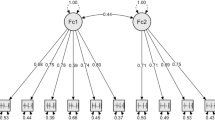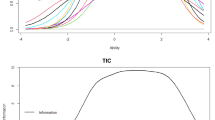Abstract
In this study, the relative fits of three different factor-structure models of adolescent reckless behavior were examined using the Reckless Behavior Questionnaire (RBQ) with individual samples of college and high school students. Both one- and two-factor models were found to be satisfactory representations of the RBQ with both samples. In order to test the construct validity of the one- and two-factor models, relations between instruments generally associated with reckless behavior were examined by gender. Using the two-factor model, gender differences were found for both the college and high school samples; thus, it was determined to be the more parsimonious fit of the data given previous research supporting gender differences. Findings are discussed in terms of current conceptualizations of factor patterns of adolescent problem behavior and implications for future investigations.
Similar content being viewed by others
References
Anglin, M. D., Thompson, J. P., and Fisher, D. G. (1986). Parental, personality, and peer correlates of psychoactive mushroom use.J. Drug Educat. 16: 265–285.
Apfeldorf, M., and Hunley, P. J. (1975). Application of MMPI alcoholism scales to older alcoholics and problem drinkers.J. Studies Alcohol 17: 654–653.
Arnett, J.(1989). Factors related to reckless behavior among adolescents. Paper presented at the biennial meeting of the Society for Research in Child Development, Kansas City, MO.
Arnett, J. (1990, March). Adolescents and heavy metal music: From the mouths of metalheads. Paper presented at the biennial meeting of the Society for Research on Adolescence, Atlanta, GA.
Arnett, J. (in press). Reckless behavior in adolescence: An integrative developmental theory.Develop. Rev.
Cairns, R. B. (1990, March). Group dynamics and rise of firearms. Paper presented at the biennial meeting of the Society for Research on Adolescence, Atlanta, GA.
Cattell, R. (1958). Extracting the correct number of factors in factor analysis.Educat. Psychol. Measure. 18: 791–837.
Cattell, R. (1965). Factor analysis: An introduction to essentials. (I) The purpose and underlying models.Biometrics 21: 190–215.
Clark, D. C., Sommerfeldt, L., Schwarz, M., Hedeker, D., and Watel, L. (1990). Physical recklessness in adolescence? Trait or byproduct of depressive/suicidal states?J. Nerv. Mental Dis. 178: 423–433.
Demo, D. H. (1985). The measurement of self-esteem: Refining our methods.J. Personal. Social Psychol. 48: 1490–1502.
Donovan, J. E., and Jessor, R. (1985). Structure of problem behavior in adolescence and young adulthood.J. Consult. Clin. Psychol. 53: 890–904.
Donovan, J. E., Jessor, R., and Costa, F. M. (1988). Syndrome of problem behavior in adolescence. A replication.J. Consult. Clin. Psychol. 56: 762–765.
Greene, R. L. (1980).The MMPI: An Interpretive Manual. Grune & Stratton, Orlando, FL.
Jackson, D. N. (1967).Personality Research Form Manual. Research Psychologists Press, Port Huron, MI.
Jackson, D. N., and Morf, E. M. (1973). An empirical evaluation of factor reliability.Multivar. Behav. Res. 9: 439–459.
Jessor, R., and Jessor, S. L. (1977).Problem Behavior and Psychosocial Development: A Longitudinal Study of Youth. Academic Press, New York.
Kim, J. O., and Mueller, C. W. (1978).Factor Analysis: Statistical Methods and Practical Issues. Sage University Press, Beverly Hills, CA.
MacAndrew, C. (1965). The differentiation of male alcoholic outpatients from nonalcoholic psychiatric outpatients by means of the MMPI.Quart. J. Studies Alcohol 26: 238–246.
McDonald, R. P. (1985).Factor Analysis and Related Methods.Lawrence Erlbaum Associates, Hillsdale, NJ.
Philliber, S., Namerow, P. B., Kaye, J. W., and Kunkes, C. H. (1986). Pregnancy risk taking among adolescents.J. Adoles. Res. 1: 463–481.
Rhodes, R. J. (1969). The MacAndrew alcoholism scale: A replication.J. Clin. Psychol. 25: 189–191.
Rosenberg, M. (1965).Society and the Adolescent Self-image. Princeton University Press, Princeton, NJ.
Rosenberg, M. (1979).Conceiving the Self. Basic Books, New York.
Rummel, R. J. (1970).Applied Factor Analysis. Northwestern University Press, Evanston, IL.
Seigel, R. A., and Ehrlich, A. (1989). A comparison of personality characteristics, family relationships, and drug-taking behavior in low and high socioeconomic status adolescents who are drug abusers.Adolescence 24: 925–936.
SPSS-X User's Guide. (1986). Chicago, SPSS Incorporated.
Stumpf, H., and Wieck, T., and Jackson, D. N. (1976).Personality Research Form. Revidierte uebersetzung, Psychologisches Institut der Unversitaet Bonn.
Thorson, J. A., and Powell, F. C. (1987). Factor structure of a lethal behaviors scale.Psychol. Rep. 61: 807–810.
Uecker, A. E. (1970). Differentiating male alcoholics from other psychiatric inpatients: Validity of the MacAndrew scale.Q. J. Studies Alcohol 31: 379–383.
U.S. Bureau of the Census. (1987).Statistical Abstracts of the United States (108th edition). Washington, DC.
Vega, A. (1971). Cross-validation of four MMPI scales for alcoholism.Q. J. Studies Alcohol. 32: 791–797.
Wagner, E. F., and Shaw, D. S. (1990, March). Reckless behavior in adolescence: An examination of psychological factors, paper presented at the biennial meeting of the Society for Research on Adolescence, Atlanta, GA.
Wylie, R. C. (1974).The Self-Concept: Volume 1. University of Nebraska Press, Lincoln.
Zelnick, M., and Kanter, J. F. (1980). Sexual activity, contraceptive use and pregnancy among metropolitan-area teenagers: 1971–1979.Family Plan Perspect. 12: 230–237.
Zucker, R. A., and Barron, F. H. (1973). Parental behaviors associated with problem drinking and antisocial behavior among adolescent males. In Chafetz, M. E. (ed.),Proceedings of the First Annual Alcoholism Conference of the National Institute on Alcohol Abuse and Alcoholism (DHEW Publication No. NIH 74-675). U.S. Government Printing Office, Washington, DC.
Zuckerman, M. (1984). Sensation seeking: A comparative approach to a human trait.Behav. Brain Sci. 7: 413–471.
Zuckerman, M. (1980). Sensation seeking and its biological correlates.Psychol. Bull. 88: 187–214.
Zuckerman, M., Eysenck, S., and Eysenck, H.J. (1978). Sensation seeking in England and America: Cross-cultural, age, and sex comparisons.J. Consult. Clin. Psychol. 46: 139–149.
Author information
Authors and Affiliations
Additional information
B.A. from Oberlin College, and M.A. and Ph.D. in Psychology from University of Virginia. Research interests are development of aggression and correlates of reckless behavior.
B.A. from University of Akron and M.S. from University of Pittsburgh. Research interests are addictive behaviors and psychopathology in adolescence.
Formerly Assistant Professor at Ogelthorpe University (1985–1988). Received B.S. from Michigan State University, and M.A. and Ph.D. from University of Virginia. Research interest is development of reckless behavior.
Received B.A. from Yale University, and M.A. and Ph.D. from University of Virginia. Research interests are developmental psychopathology and adolescence.
Rights and permissions
About this article
Cite this article
Shaw, D.S., Wagner, E.F., Arnett, J. et al. The factor structure of the Reckless Behavior Questionnaire. J Youth Adolescence 21, 305–323 (1992). https://doi.org/10.1007/BF01537020
Received:
Accepted:
Issue Date:
DOI: https://doi.org/10.1007/BF01537020




